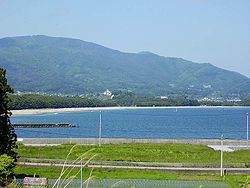Rehabilitating a whale specimen
Autor/Urheber:
National Museum of Nature and Science (Tokio/Japan)
Attribution:
Das Bild ist mit 'Attribution Required' markiert, aber es wurden keine Informationen über die Attribution bereitgestellt. Vermutlich wurde bei Verwendung des MediaWiki-Templates für die CC-BY Lizenzen der Parameter für die Attribution weggelassen. Autoren und Urheber finden für die korrekte Verwendung der Templates hier ein Beispiel.
Shortlink:
Quelle:
Größe:
892 x 728 Pixel (120314 Bytes)
Beschreibung:
Source: "Cultural Heritage and Preservation", in: Federica Ranghieri, Mikio Ishiwatari (eds.): "Learning from Megadisasters - Lessons from the Great East Japan Earthquake", World Bank Publications, Washington, DC, 2014, ISBN (paper): 978-1-4648-0153-2, ISBN (electronic): 978-1-4648-0154-9, DOI: 10.1596/978-1-4648-0153-2, Chapter 35, pp. 323-329, here: p. 324, Figure 35.1
("Rehabilitating a whale specimen - Source: National Museum of Nature and Science."), License: Creative Commons Attribution CC BY 3.0 IGO.
Context given in the above cited source: "National government schemes after the GEJE: The ACA started two schemes following the GEJE: (1) “cultural property rescue” to preserve historical materials and art objects, and (2) “cultural property doctor” to preserve historical buildings. Donations of some ¥270 million were received from the public for these activities during the year following the disaster. Cultural property rescue. This scheme was aimed at preserving or rescuing historical materials and art objects such as documents, paintings, sculptures, and crafts. The ACA formulated a rescue committee that consisted of research organizations, museums, libraries, the private sector, and civil society organizations (CSOs) throughout the country. Some 4,900 experts had participated in the scheme as of March 2012. In Miyagi Prefecture, expert teams rescued dozens of properties at 58 locations consisting of museums, schools, private houses, temples, and shrines. For example, at the Ishinomaki Cultural Museum, which was severely damaged by tsunami waves, these experts fumigated, cleaned, dried, or rehabilitated folklore materials, arts, crafts, unearthed human bones, and historical maps. They then transported and stored these artifacts at other museums, universities, and private warehouses in Sendai and Tokyo. The experts rescued statues of the Buddha and scriptures from damaged temples. The scheme also covered zoological and botanical specimens at natural history museums. Experts ehabilitated a stuffed specimen of a whale measuring some 10 meters from a maritime museum in Rikuzentakata City, moving it to the National Museum of Nature and Science in Tokyo (figure 35.1). The Japan Self- Defense Forces, a signifi cant presence in response works following the GEJE (chapter 14), helped to transport these heavy materials. Before the GEJE, the ACA was not well prepared for megadisasters. Rescue activities began only after some 20 days had passed. Damage to historical records from saltwater and mold had already set in. Experts were selected on an ad hoc basis. The organizations to which the experts belonged had to cover travel costs at the initial stage because the ACA did not have any extra travel budget for disasters. The procedures for requesting and dispatching experts were confusing and the recovery processes complicated. To be most effective, preservation projects must begin immediately after a disaster. Architects and building experts participated in the scheme, “Doctors for Buildings: Diagnosing and Treating Damage to Historic Buildings.” They assessed damages and provided technical advice for preserving and rehabilitating historical buildings. In total, 467 experts conducted activities on 3,936 buildings in 198 municipalities before March 2012. In the second year, the experts provided building owners with detailed advice on methods and cost estimates for preserving and rehabilitating works."
Kommentar zur Lizenz:
|
|
Diese Datei ist lizenziert unter der Creative-Commons-Lizenz „Namensnennung 3.0 IGO“. |
|
|
Lizenz:
Credit:
"Cultural Heritage and Preservation", in: Federica Ranghieri, Mikio Ishiwatari (eds.): "Learning from Megadisasters - Lessons from the Great East Japan Earthquake", World Bank Publications, Washington, DC, 2014, ISBN (paper): 978-1-4648-0153-2, ISBN (electronic): 978-1-4648-0154-9, DOI: 10.1596/978-1-4648-0153-2, Chapter 35, pp. 323-329, here: p. 324, Figure 35.1 ("Rehabilitating a whale specimen - Source: National Museum of Nature and Science."), License: Creative Commons Attribution CC BY 3.0 IGO.
Relevante Bilder


(c) Anawat Suppasri, Nobuo Shuto, Fumihiko Imamura, Shunichi Koshimura, Erick Mas, Ahmet Cevdet Yalciner, CC BY 2.0


(c) Anawat Suppasri, Nobuo Shuto, Fumihiko Imamura, Shunichi Koshimura, Erick Mas, Ahmet Cevdet Yalciner, CC BY 2.0








(c) Satoh Junpei, CC BY-SA 3.0







(c) yano@mama.akari.ne.j…, CC BY-SA 3.0










(c) Yoshio Kohara, CC BY 3.0
Relevante Artikel
RikuzentakataRikuzentakata ist eine Stadt in der Präfektur Iwate auf Honshū, der Hauptinsel von Japan. .. weiterlesen
